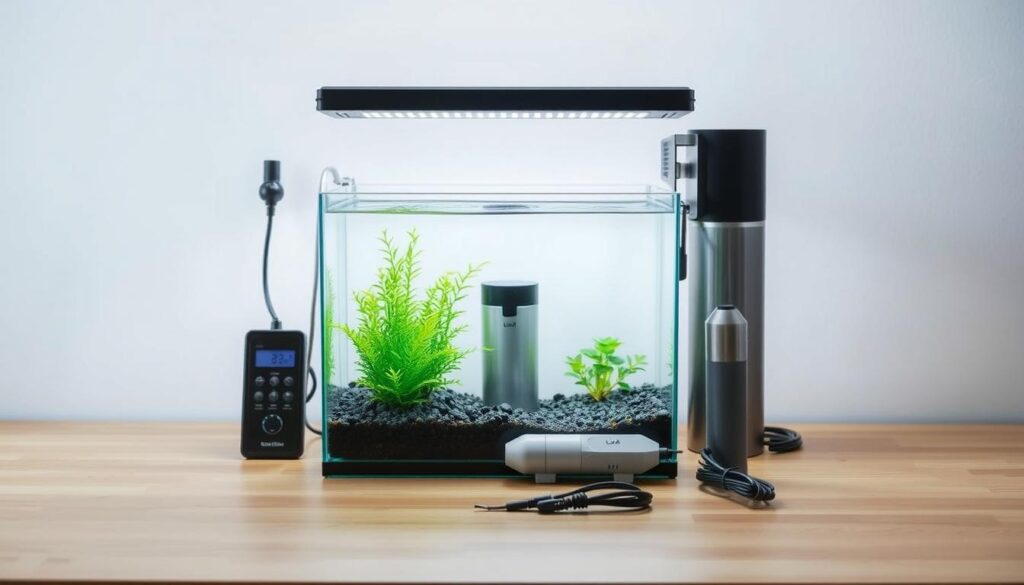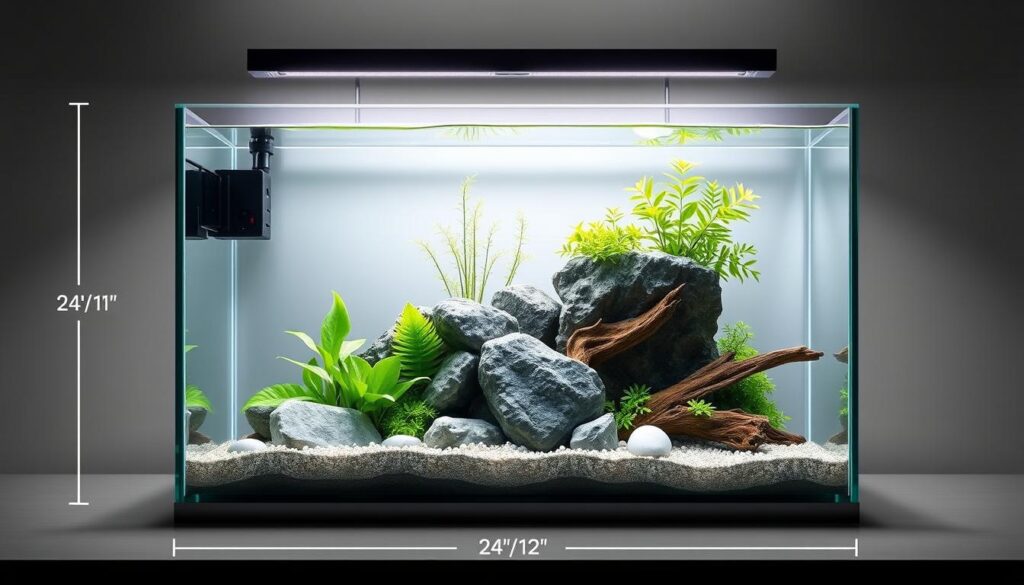If you’re planning a new fish tank, knowing the exact 15 gallon aquarium dimensions is essential. Whether you’re setting up a home for your betta, guppies, or a small planted tank, understanding 15 gallon aquarium dimensions helps you choose the right space and stand. Typically, 15 gallon aquarium dimensions are around 24” L x 12” W x 12” H, but this can vary slightly depending on the brand or tank style (high vs. long). In this article, we’ll dive into everything you need to know about 15 gallon aquarium dimensions so you can build the perfect aquatic environment with confidence.
We’re excited to help you get started on your aquarium journey! In this article, we’ll cover the essential dimensions and specifications to make your tank shine.
Key Takeaways
- Standard dimensions for a 15-gallon aquarium
- Weight considerations for your tank
- Tips for setting up a thriving aquatic ecosystem
- Essential specifications for a healthy aquarium
- Getting started with your 15-gallon tank
Standard 15 Gallon Aquarium Dimensions and Specifications
Understanding the standard dimensions of a 15-gallon aquarium is crucial for a successful setup. You need to know the measurements to ensure you have enough space and the right equipment for your tank.
Common Measurements and Proportions
A standard 15-gallon aquarium typically measures 24 inches in length, 12 inches in width, and 12 inches in height. These dimensions provide a good balance between water volume and surface area, making it easier to maintain a healthy environment for your fish.
The proportions of your tank can also impact its overall aesthetic. A longer tank provides more swimming space for your fish, while a taller tank can create a more dramatic display.
Weight Considerations When Filled
The weight of a 15-gallon aquarium when filled is substantial. The water alone weighs around 125 pounds, assuming 8.34 pounds per gallon. Adding gravel, decorations, and equipment can increase this weight to around 146 pounds or more.
You need to ensure that the surface where you place your tank can support this weight. A sturdy table or cabinet is essential to prevent any accidents or damage.
Glass vs. Acrylic Construction
15-gallon aquariums are typically made from either glass or acrylic. Glass tanks are more scratch-resistant and provide a clearer view, while acrylic tanks are lighter and less prone to shattering.
| Material | Pros | Cons |
|---|---|---|
| Glass | Scratch-resistant, clear view | Heavier, prone to shattering |
| Acrylic | Lighter, less prone to shattering | More prone to scratches |
Ultimately, the choice between glass and acrylic comes down to your personal preference and specific needs.
Types of 15 Gallon Fish Tanks Available
When it comes to 15-gallon aquariums, you’ve got more options than you think! The variety in shapes and styles can make choosing the right one both exciting and challenging.
Standard Rectangular Tanks
Standard rectangular 15-gallon tanks are a popular choice among aquarium enthusiasts. They offer ample space for fish and decorations while fitting neatly into most home decor styles. Their dimensions typically follow standard 15 gallon tank dimensions, making it easy to find accessories and equipment.
15 Gallon Long Tanks
If you’re looking for a bit more swimming space for your fish, consider a 15-gallon long tank. These tanks are designed to provide a larger surface area, which can be beneficial for certain fish species. Their 15 gallon fish tank size is ideal for creating a dynamic underwater landscape.
15 Gallon Column/Tall Tanks
For those with limited space, 15-gallon column or tall tanks are a great option. They offer a unique visual experience, with the ability to create a tall, lush environment for your fish. Keep in mind that the height can affect the 15 gallon tank dimensions, so ensure you have a sturdy surface to support the weight.
Specialty and Custom Shapes
Beyond the standard shapes, there are also specialty and custom 15-gallon aquariums available. These can range from unique geometric shapes to custom-built designs that fit specific spaces or themes. Whether you’re looking for something sleek and modern or quirky and fun, there’s likely a 15-gallon tank that fits your vision.
With so many options, you’re sure to find the perfect 15-gallon fish tank to suit your style and the needs of your aquatic friends.
Choosing the Perfect Location for Your 15 Gallon Tank
Your 15-gallon tank’s location can make or break its ecosystem – let’s get it right! When deciding where to place your tank, you need to consider a few critical factors.
Weight-Bearing Surface Requirements
First and foremost, ensure that the surface can support the weight of your filled 15-gallon tank, which is approximately 170 lbs. You’ll need a sturdy table or cabinet that won’t buckle under the weight.
Temperature and Light Considerations
Next, think about the temperature and lighting in the area. Avoid placing your tank near drafty windows, radiators, or air conditioning vents, as this can cause temperature fluctuations. Also, consider the lighting – too much direct sunlight can lead to algae growth.
Accessibility for Maintenance
Finally, choose a location that allows easy access for maintenance tasks like water changes and cleaning. You’ll be glad you did when it’s time to get to work!
| Location Factor | Considerations |
|---|---|
| Weight-Bearing Surface | Ensure the surface can support 170 lbs |
| Temperature | Avoid drafty areas and extreme temperatures |
| Lighting | Minimize direct sunlight to prevent algae growth |
| Accessibility | Choose a spot that allows easy maintenance access |
Essential Equipment for a 15 Gallon Aquarium Setup
Setting up a 15-gallon aquarium requires more than just water and fish; it demands the right equipment to create a thriving environment! To get started, you’ll need to focus on a few key areas: filtration, heating, lighting, and additional equipment that’ll make maintaining your tank a breeze.
Filtration Systems Sized for 15 Gallons
A good filtration system is the backbone of any aquarium. For a 15-gallon tank, you’ll want to consider a hang-on-back filter or a canister filter. These systems are designed to handle the water volume of your tank, keeping it clean and clear. When choosing a filter, make sure it’s rated for at least 15 gallons to ensure optimal performance!

Appropriate Heating Options
If you’re planning to keep tropical fish, you’ll need a heater to maintain a warm water temperature. Look for a submersible heater that’s designed for your tank’s size – typically around 50-100 watts for a 15-gallon aquarium. This will help keep the water at a comfortable temperature for your fish, usually between 76-82°F.
Lighting Solutions for Different Setups
Lighting is not just about making your tank look great; it also plays a crucial role in the health of your fish and plants. For a 15-gallon tank, you can choose from a variety of lighting options, including LED, T5, or T8 lights. Consider the type of fish and plants you’re keeping when selecting your lighting – some require more intense lighting than others.
Additional Equipment: Air Pumps, Thermometers, and Timers
Beyond the basics, there are a few additional pieces of equipment that can enhance your aquarium experience. An air pump can help increase oxygen levels, while a thermometer ensures your heater is working correctly. Timers can automate your lighting schedule, simulating a natural day-night cycle for your aquatic friends.
Setting Up Your 15 Gallon Aquarium Step-by-Step
Let’s get started on turning your 15-gallon aquarium into a stunning aquatic oasis! Setting up a new 15 gallon fish tank requires careful planning and attention to detail, but don’t worry, we’ve got you covered.
Initial Setup and Placement
First things first, you need to choose the perfect spot for your standard 15 gallon aquarium dimensions tank. Make sure it’s away from direct sunlight, drafts, and extreme temperatures. Ensure the surface is level and can support the weight of the tank when filled.
Substrate Selection and Installation
Choosing the right substrate is crucial for your aquarium’s ecosystem. You can opt for gravel, sand, or a mix, depending on the type of fish and plants you plan to keep. Rinse the substrate thoroughly before adding it to your tank.
Cycling Methods for New Tanks
Cycling your tank is a critical step before introducing fish. This process establishes a healthy biological balance, allowing beneficial bacteria to colonize and break down waste. You can cycle your tank using fishless cycling methods or by introducing a small number of hardy fish.
Water Parameters and Testing Protocols
Regular water testing is essential to maintain a healthy environment. Monitor parameters like pH, ammonia, nitrite, and nitrate levels. Invest in a good quality water test kit and establish a regular testing schedule to ensure your tank remains stable.
By following these steps and being patient, you’ll be well on your way to creating a thriving aquatic environment in your 15-gallon aquarium. Happy aquarium-keeping!
Stocking Options for a 15 Gallon Tank
The right mix of fish, invertebrates, and plants can turn your 15-gallon aquarium into a thriving underwater ecosystem. When stocking your tank, it’s essential to consider the adult size of the fish and their bioload to create a balanced environment.
Appropriate Fish Species and Quantities
Choosing the right fish for your 15-gallon tank involves considering their adult size, temperament, and schooling behavior. For a tank of this size, it’s best to opt for small to medium-sized peaceful fish.
Schooling Fish Options
Schooling fish like Neon Tetras or Harlequin Rasboras are excellent choices for a 15-gallon tank. They add movement and color, and their schooling behavior creates a captivating display.
Centerpiece Fish Choices
For a centerpiece fish, consider peaceful species like Dwarf Gouramis or Betta Fish. These fish can be the focal point of your tank and add visual interest.
Invertebrate Possibilities
Invertebrates like Snails and Shrimps can add diversity to your tank. They’re generally low-maintenance and can help with algae control. When choosing invertebrates, ensure they’re compatible with your fish and tank conditions.

Plant Selection for 15 Gallon Tanks
Plants are a crucial element in creating a thriving aquarium ecosystem. For a 15-gallon tank, consider plants like Java Moss, Anubias, or Cryptocorynes. These plants are relatively low-maintenance and can thrive in a well-lit tank.
Understanding Bioload Limitations
Bioload refers to the amount of waste produced by your aquatic life. Understanding bioload limitations is crucial to maintaining a healthy tank. Overstocking can lead to water quality issues and stress on your fish. Always research the adult size and bioload of your chosen fish before adding them to your tank.
By carefully selecting your fish, invertebrates, and plants, and understanding the bioload limitations, you can create a vibrant and thriving 15-gallon aquarium that brings joy and relaxation to your space.
Specialized 15 Gallon Aquarium Setups
Let’s dive into the world of specialized 15-gallon aquarium setups and explore the possibilities! With a 15-gallon tank, you can create a unique and thriving aquatic environment that’s tailored to your interests and the needs of your aquatic friends.
Planted Tank Configurations
A planted tank is a great way to add some extra beauty and life to your aquarium. By incorporating live plants, you can create a natural and balanced ecosystem that benefits both your fish and plants. When choosing plants for your 15-gallon tank, consider species that are suitable for smaller spaces and can thrive in a closed environment.
Some popular options include Java moss, Anubias, and Cryptocorynes. These plants are relatively low-maintenance and can tolerate a range of lighting conditions. To create a visually appealing planted tank, consider varying the texture and height of your plants to create a layered effect.
Biotope-Specific Setups
A biotope-specific setup involves recreating a specific natural environment within your aquarium. This can be a fun and challenging project, as it requires careful research and attention to detail. When creating a biotope-specific setup, consider the specific needs and characteristics of the environment you’re trying to replicate.
For example, if you’re creating a Amazonian biotope, you might include plants like Cabomba or Amazon swordplants, and decorate with driftwood and rocks to mimic the natural habitat. By recreating a specific biotope, you can create a unique and fascinating aquarium that showcases the natural beauty of the underwater world.
Species-Specific Tanks
A species-specific tank is designed to meet the specific needs of a particular species or group of species. This can be a great way to create a tailored environment that promotes the health and well-being of your fish. When setting up a species-specific tank, research the specific needs of your chosen species, including their dietary requirements, water parameters, and social needs.
Breeding Setups in 15 Gallon Tanks
Breeding fish in a 15-gallon tank can be a rewarding experience, but it requires careful planning and attention to detail. When setting up a breeding tank, consider the specific needs of the species you’re working with, including their spawning habits and the requirements for raising fry.
By providing a suitable environment and careful management, you can successfully breed a variety of species in a 15-gallon tank. Remember to research the specific needs of your chosen species and plan accordingly to ensure a successful breeding program.
Read Also Betta Fish Natural Habitat: Recreate Their Ideal Home
Maintaining Your 15 Gallon Aquarium
To keep your 15-gallon aquarium in top condition, regular maintenance is not just recommended, it’s essential! Regular water changes, equipment checks, and a clean environment are crucial for the health and happiness of your aquatic life.
Weekly Maintenance Schedule
Every week, you should perform a few key tasks. First, check your water parameters using a quality test kit. This helps you catch any imbalances before they become major issues. Next, change about 10-15% of your tank water to keep it fresh. Don’t forget to clean the glass walls of your tank to keep it looking its best!
Monthly Maintenance Tasks
On a monthly basis, you’ll need to do a deeper clean. This includes vacuuming the gravel to remove debris and cleaning or replacing filter media as needed. It’s also a good idea to inspect your equipment for any signs of wear or malfunction.
Water Change Protocols
When changing water, make sure the new water is the same temperature as the tank water to avoid shocking your fish. Use a water conditioner to remove chlorine and chloramines from tap water. Remember, the goal is to maintain stable water parameters, so be consistent with your water changes.
Equipment Cleaning and Replacement
Regularly clean your equipment according to the manufacturer’s instructions. Over time, some parts may need to be replaced. Keep an eye on your filter media, heater, and other critical components to ensure they’re functioning properly.
By following these maintenance tips, you’ll be well on your way to enjoying a thriving 15-gallon aquarium. Remember, consistency is key, and a little effort each week goes a long way in keeping your aquatic environment healthy and happy!

Alternative Uses for a 15 Gallon Tank
Beyond fish keeping, a 15-gallon tank offers a world of possibilities for other fascinating pets! You might be surprised at the variety of creatures you can house in this size tank.
15 Gallon Reptile and Amphibian Habitats
A 15-gallon tank is an ideal size for many reptiles and amphibians, providing ample space for a well-ventilated, temperature-controlled environment. When setting up a reptile or amphibian habitat, it’s crucial to consider the specific needs of your pet.
Suitable Species for This Size
Some popular choices for a 15-gallon reptile or amphibian tank include bearded dragons, geckos, and certain species of frogs. These animals have different requirements, so research your pet’s needs thoroughly.
Special Setup Requirements
For reptiles, you’ll need to include a heat source, UVB lighting, and a substrate that’s safe for burrowing. Amphibians, on the other hand, require a more humid environment, often with live plants and a water area for swimming.
Paludarium and Vivarium Configurations
A 15-gallon tank can be transformed into a stunning paludarium or vivarium, combining water and land elements to create a unique ecosystem. These setups can be particularly rewarding, allowing you to cultivate both aquatic and terrestrial plants.
When designing a paludarium or vivarium, consider the balance between water and land areas, as well as the lighting and humidity requirements for the plants and animals you’ll be housing.
Temporary Quarantine or Hospital Tank Setup
A 15-gallon tank can also serve as a temporary quarantine or hospital tank for fish or other aquatic animals. This is especially useful when you need to isolate a sick animal or acclimate new pets to your main tank.
To set up a quarantine tank, focus on creating a clean, stable environment with appropriate filtration and temperature control. This will help your animals recover or adjust to their new surroundings.
Conclusion: Enjoying Your Perfect 15 Gallon Aquarium
Now that you’ve set up your 15 gallon aquarium, it’s time to sit back and enjoy the fruits of your labor! With the right 15 gallon aquarium dimensions and a well-planned 15 gallon fish tank size, you’ve created a thriving aquatic environment.
As you continue to care for your aquarium, remember to monitor water parameters, perform regular maintenance, and make adjustments as needed. Your 15 gallon tank will flourish with the right balance of fish, plants, and equipment.
Whether you’re a seasoned aquarist or just starting out, we encourage you to share your experiences and connect with others who share your passion. By doing so, you’ll not only enhance your own knowledge but also contribute to a community that celebrates the joy of aquarium keeping!
Read Also What Size Tank is Best for a Betta Fish?

